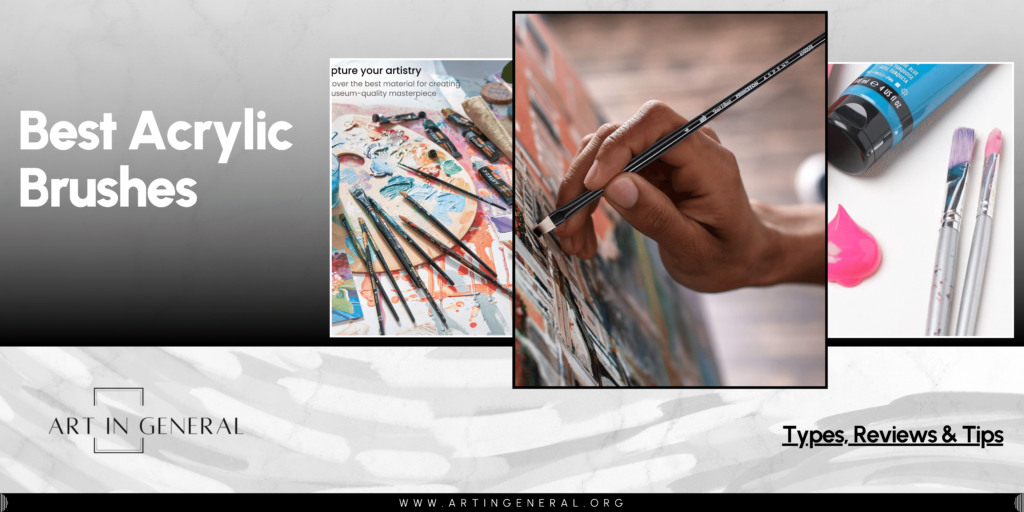
It is a common experience, especially for beginner artists, to enter an art store expecting to buy some brushes and come out either empty handed and feeling overwhelmed, or with the wrong brushes and having spent too much or too little. Experienced artists will understand the struggle we’ve all felt when faced with the many many options that craft stores and online stores give us, especially when we don’t know much about brushes. But don’t worry, in this article we’re going to take your hand and guide you through the vast sea of brush choices. From the basics of brush anatomy, to the different brushes you’re going to need for your acrylic painting journey, this guide has it all to help you make an informed decision.
We’re also going to present you with a carefully curated list of the best brushes, brands, and brush sets so that you can start painting right away. Let’s get started!
Anatomy of A Brush
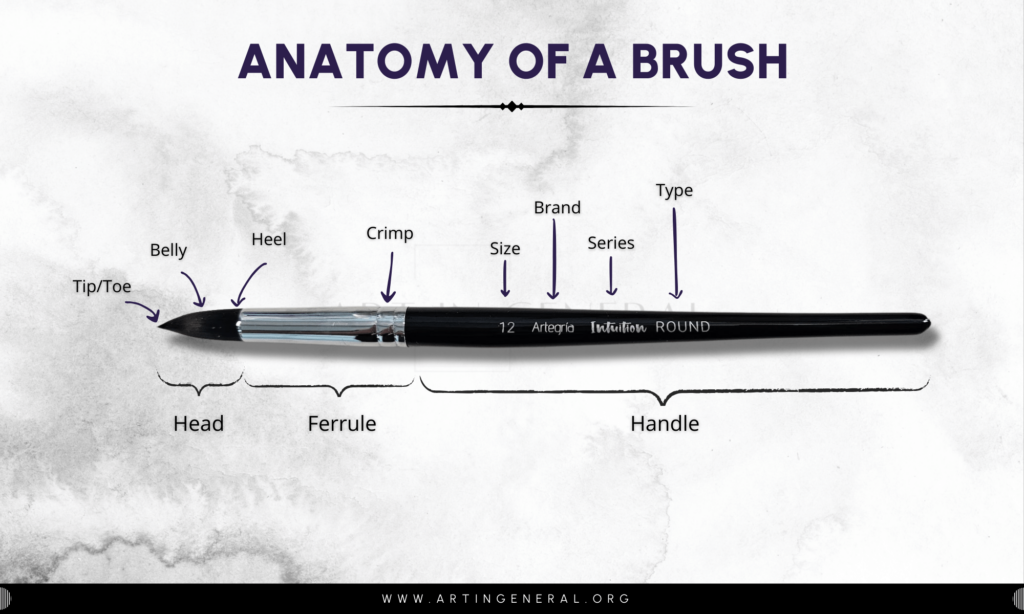
The anatomy of a brush consists of three parts, the “head”, the “ferrule” and the “handle”, each of these parts plays a key role in the painting process.
The Head
The Head is where the bristles are, and has three parts, the toe which can be of any shape, the belly which holds water or paint depending on how thick it is, and the heel which inserts into the ferrule and is usually held together by glue.
The Ferrule
The Ferrule is the metallic part that holds the bristles and the handle together, providing stability and security when painting. In high-quality brushes, the ferrule is securely crimped to the handle, a process that reduces the likelihood of the bristles becoming loose or the ferrule detaching from the handle.
The Handle
The Handle is the part that you hold while painting, the largest part of the brush. It can be short or long, be made of wood, metal, plastic or even rubber in some cases. This part has information about the bruhs, like the brand, size, shape, series, number, collection, etc.
Types of Acrylic Brushes
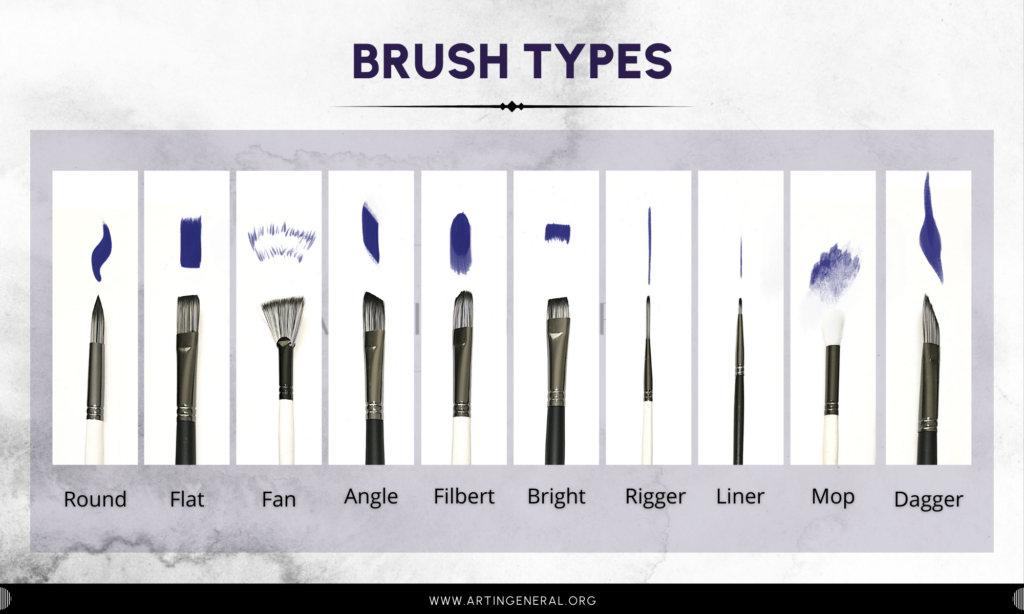
There are different types of acrylic brushes you can use for painting, but the ones you’ll come across the most categorized according to their shape are:
Round Brushes
Round brushes have a rounded tip and are tapered to a fine point.
Uses: Ideal for detailing, outlining, and filling in small areas. They offer good control for thin to thick lines.
Flat Brushes
Flat brushes have a square end with medium to long bristles.
Uses: Perfect for filling wide spaces, bold strokes, washes, and blending.
Fan Brushes
Fan brushes spread bristles in a fan shape.
Uses: Useful for blending, smoothing, and creating textures such as foliage or hair.
Angle Brushes
These brushes have an angled or slanted tip.
Uses: Excellent for curves, filling corners, and precise control on edges. They’re also great for shading and highlighting.
Filbert Brushes
Filbert brushes combine aspects of round and flat brushes, with a rounded, oval tip.
Uses: Great for blending and soft, rounded edges. They’re versatile for both broad strokes and detailing.
Bright Brushes
Similar to flat brushes but with shorter bristles.
Uses: Offer excellent control for thick paints. Good for short, controlled strokes and thick, heavy color application.
Rigger Brushes
Rigger brushes are long, thin, and round.
Uses: Originally designed for painting the rigging on ships, they’re perfect for long, continuous lines and fine details.
Liner Brushes
Liner brushes are similar to round brushes but with longer bristles.
Uses: Best for fine lines, lettering, and intricate detail work.
Mop Brushes
Mop brushes have a large, round, and fluffy shape.
Uses: Ideal for large areas, washes, and soft blending. They can hold a lot of paint and water.
Dagger Brushes
Dagger brushes have a unique shape with a slanted, pointy tip, resembling a dagger.
Uses: They’re versatile for creating sharp lines, filling, and detail work, offering a mix of capabilities between flat and angle brushes.
Oval Wash Brushes
These brushes have a rounded, flat shape designed for creating washes.
Uses: Good for covering large areas, blending, and applying glazes.
Natural vs. Synthetic Brushes
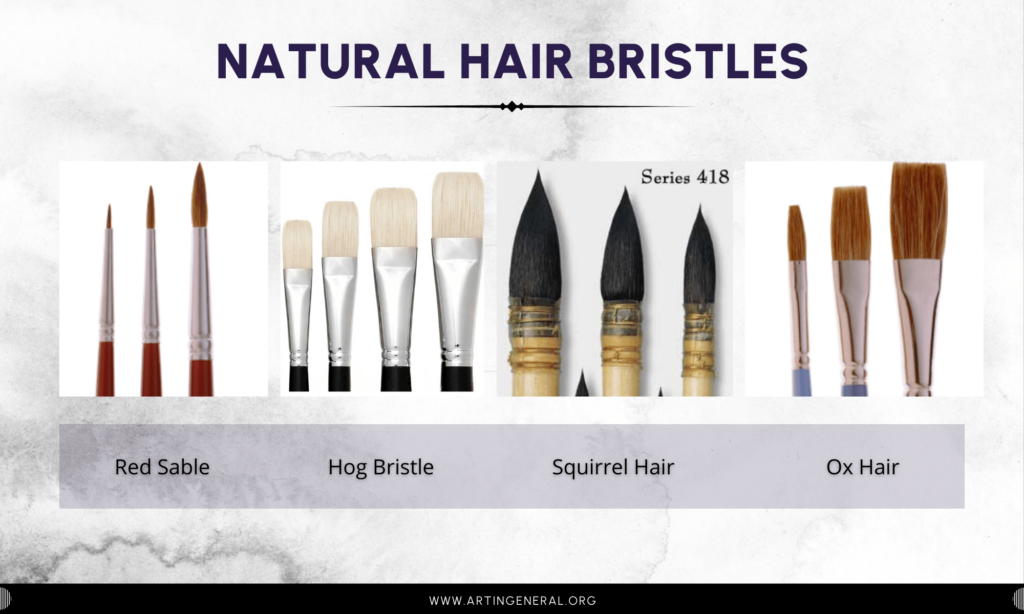
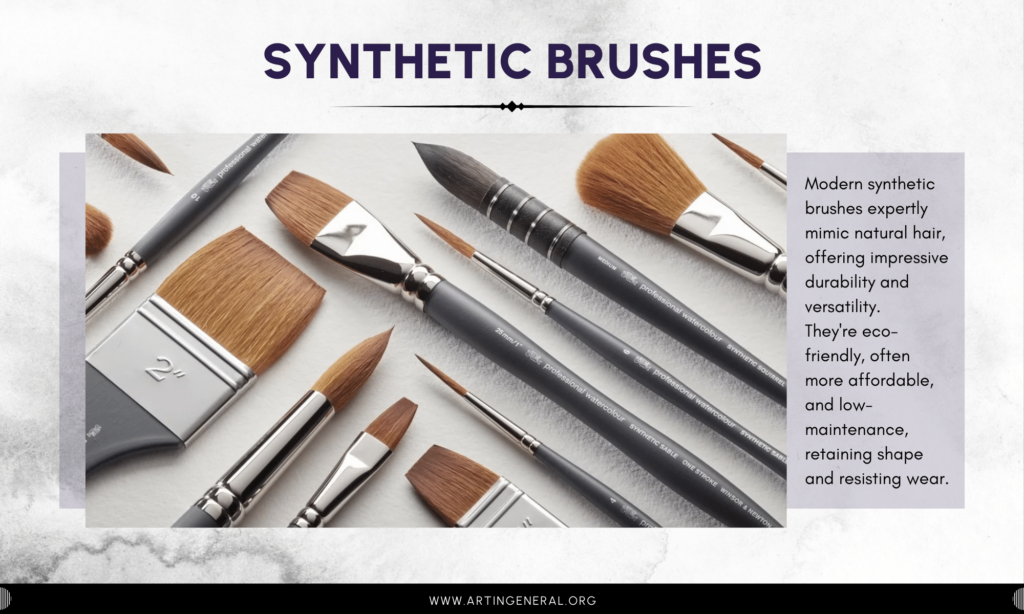
Some brushes will have different effects depending on the material they’re made of, for example, a synthetic, softer fan brush can be used to add texture and create beautiful foliage effects while a natural hair, rougher fan brush is used for blending colors together and adding light effects with dry brushing techniques.
However not all natural hair brushes are rougher or coarser, some are extremely soft (and extremely expensive) and are not made for acrylics, which is why you should know which natural hair materials to look for and when to use them.
- Red Sable: Offers a good point and spring, though not as premium as Kolinsky, but still provides smooth paint application.
- Ideal for: Detailed work and situations where a balance between precision and paint load is needed.
- Hog Bristle: Stiffer and more durable than sable, hog bristle can handle thicker paint.
- Ideal for: Techniques that require texture, such as impasto, or when heavy body acrylics are used.
- Squirrel: Very soft and absorbent, providing smooth, broad applications with minimal brush strokes.
- Ideal for: Large washes, glazing, and achieving watercolor-like effects with diluted acrylics.
- Ox Hair: Slightly stiffer than sable but softer than hog, offering a good balance of flexibility and durability.
- Ideal for: Filling broader areas with a softer touch than hog bristle, suitable for blending and smoother applications.
If you’re a beginner, we recommend always going for synthetic brushes, these are much more affordable and offer a good selection between shapes, sizes and stiffness, however if you do end up getting natural hair brushes, always remember to buy a care kit or a conditioner soap to wash and care for them properly. Acrylic paint contains chemicals that damage the bristles of the natural hair much faster than it would synthetic bristles, and without the proper care your money can end up down the drain very fast.
Key Factors to Consider Before Buying Acrylic Brushes
Brush Shape
The shape of a brush will always directly affect your painting style, the type of work you do and even define you as an artist if you limit yourself to one or two brush shapes, so we can agree that it is a very important matter to consider. While it is very easy to get carried around and get every brush shape possible (of those low quality value packs) we always recommend starting with five brushes, a medium flat, a medium round, a bright, an angle, and a small liner (to sign your art of course). You can get a fan, and a mop or a dagger and a comb once you’ve got a hold of how these four brushes work and build your toolkit from there.
Bristle Type
Deciding whether to go for natural hair brushes or synthetic brushes is not hard; we always recommend synthetic for beginners in acrylic painting due to their resilience and compatibility with the acrylic medium. However, natural hair brushes can sometimes be the right choice, especially for specific techniques that require a softer touch or a particular kind of brush stroke that synthetic fibers might not achieve as well. Although this is something you’ll come to find out later in your acrylic painting journey, it’s important to understand the benefits and limitations of each type from the start.
Remember that synthetic brushes are less prone to damage, hence they’ll last much longer and will keep their shape better, plus they’re a cruelty-free option.
Natural hair brushes, like sable or hog, offer a level of softness and flexibility and can hold paint in a way that allows for smoother application making them ideal for detailed work, blending, and glazing. They’re better suited for more advanced techniques that you may explore as you gain experience.
Size
The size of a brush will depend solely on what you want to paint. And yes, I’m talking about the specific project you’re working on. For example, if you’re working on a large painting (24 inches plus) you might want to go for larger brushes or even visit your local hardware store for large paint brushes to get the coverage you need. On the other hand, if you’re painting a miniature, you’re going to need 0 and 000 brushes, so it’ll depend on what you’re painting and when you’re painting it. We don’t recommend getting every size “just in case” but evaluating what size you usually paint on and go from there.
Handle Length
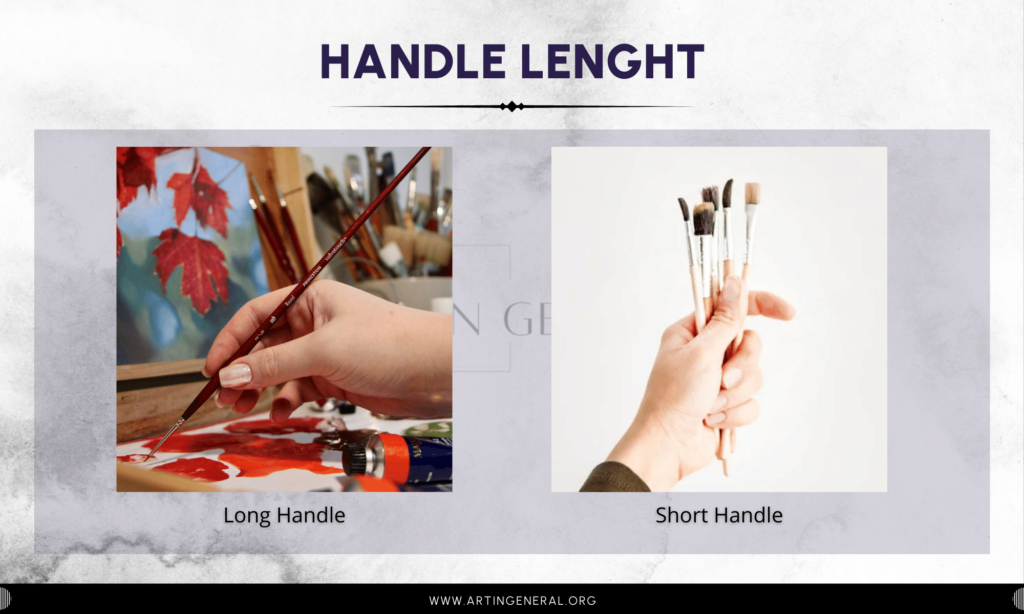
The length of the handle you choose will depend on your painting style, and if you don’t have a painting style yet, then make yourself the following questions:
- How close do I like to be to my canvas? Think about if you’re more comfortable painting up close for small details or standing back to take in the whole picture. This also helps you figure out if you work better on big or small canvases. If you like to be close to your canvas, then short handle brushes are for you, if not, long handles are the answer!
- What’s my brush-holding style and comfort level? Consider if you like to hold your brush close to the bristles for detailed work or at the end for a looser approach. Also, think about whether standing or sitting suits you best while painting. If you like to hold your bruhs close to the bristles, then short handle brushes will give you all the control your hands yearn for, if not, then long handle brushes will help your arms and body express themselves to your heart’s content
Price
The cost of paintbrushes ranges widely based on material quality, brand, and where you buy them., entry-level synthetic brushes are budget-friendly, ideal for beginners, costing a few dollars each or $10-$20 for a set. Mid-range brushes mix synthetic and natural bristles, suited for intermediate artists, with individual prices between $10 and $30 and sets from $20 to $50. Professional-grade brushes, designed for serious artists, are made from high-quality natural bristles, starting at $20 to over $100 per brush, with sets exceeding $100. Your choice should match how often you paint and the quality you’re after. While pricier brushes offer better performance, affordable ones can work well too.
Top Brushes for Acrylic Painting
- Best Acrylic Brushes Overall — Princeton Artist Brush, Catalyst Polytip Brush Set
- Best Value Pack of Acrylic Brushes — Arteza Paint Brushes
- Best Acrylic Brushes For Fine Details — Silver Brush Limited BR-1906S Bristlon Fine Detail
- Best Acrylic Brushes for Mixed Media — Princeton Velvetouch, Mixed-Media Brushes
- Best Acrylic Brushes for Beginners — Liquitex BASICS Acrylic Paint Brush
- Best Acrylic Brushes for Professionals — Princeton Aspen 6500
#1. Best Acrylic Brushes Overall— Princeton Artist Brush, Catalyst Polytip Brush Set
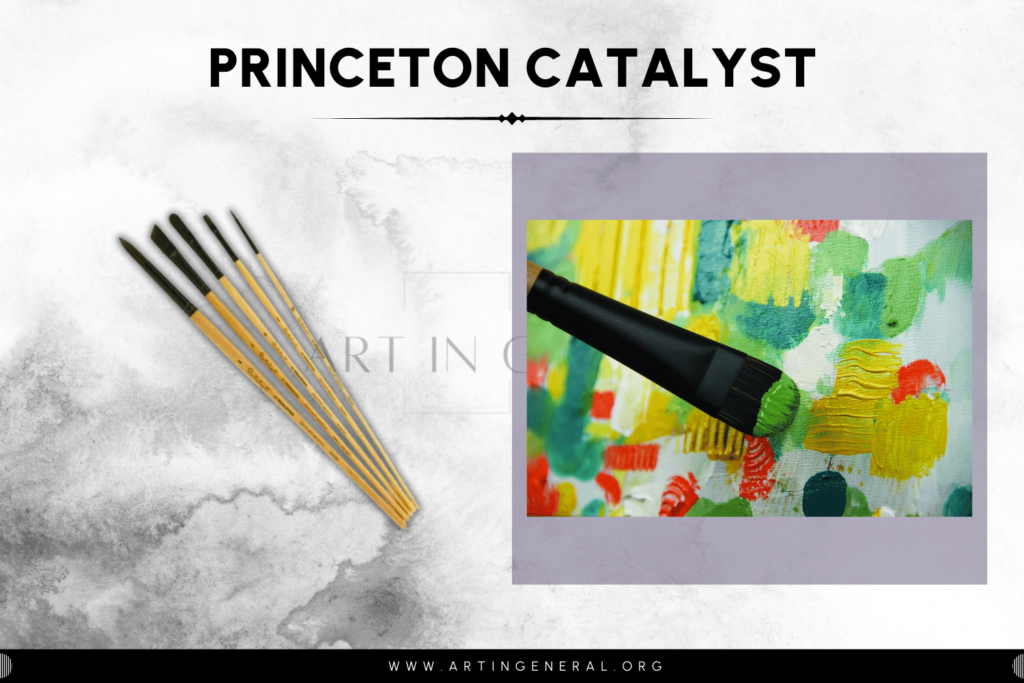
View Prices
About Princeton Artist Brush, Catalyst Polytip Brush Set
Princeton has been making the best brushes for all mediums for a while, and this is undoubtedly the best for acrylic painting. The unique feature this set offers is the unique Polytip design, where each bristle at the tips is split to mimic the natural flags of hog bristle brushes, resulting in a smoother application, making them ideal for working with heavy body acrylics.
Since these brushes are synthetic, it also means they’re extremely durable and resistant to the every-dy wear and tear from acrylic painting, including the exposure to the chemicals on the paint and the solvents on the cleaning agents and other mediums.
What makes them great:
- Presentation: 5 piece set.
- Our Score: 8/10
- Shape(s) and Size(s): Round(8); Angle(6); Filbert(4); Bright(2) and Round(2/0).
- Our Score: 8/10
- Bristle Type: Synthetic bristle hair.
- Our Score: 8/10
- Handle Length: Medium Handle
- Our Score: 8/10
- Price: $36.24
- Our Score: 9/10
Pros
- Durable synthetic bristles
- Versatile shapes/sizes
- Easy to clean
Cons
- Stiff for some
- Limited flexibility
- Higher price range
View Prices
2. Best Value Pack of Acrylic Brushes — Arteza Paint Brushes
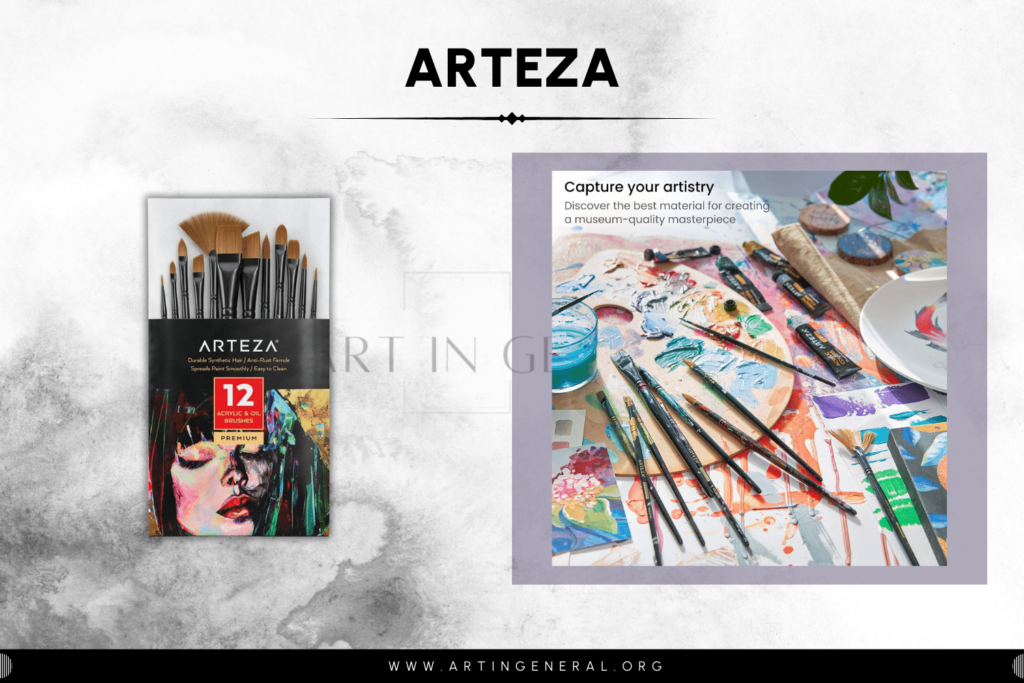
View Prices
About Arteza Paint Brushes
If you’re looking for a value pack that offers different paint brush shapes, different sizes and that doesn’t compromise on quality, then Arteza is the right answer. The 12-piece set is thoughtfully made so it has a wide shape variety with flats and rounds, essential for basic strokes, and filberts, fans and angled brushes, ideal for textured applications, sharp edges and blending.
Since the set is made from synthetic fibers it’ll be able to withstand the demands of acrylic and oil paint mediums. These bristles are designed to maintain their shape and offer a smooth application even after several uses. The handles are made from birch, known for its lightweight and comfortable grip and the ferrules are made from brass which is known to resist corrosion, making them even more durable and reliable.
What makes them great:
- Presentation:12 piece set.
- Our Score: 9/10
- Shape(s) and Size(s): Round(1,4,8); Angle(5, 10); Filbert(2, 7); Flat(6, 11); cats tongue(8).
- Our Score: 9/10
- Bristle Type: Synthetic bristle hair.
- Our Score: 8/10
- Handle Length: Not specified.
- Our Score: – – /10
- Price: $35.99
- Our Score: 9/10
Pros
- Affordable
- Multi-medium versatility
- Durable construction
Cons
- Not as high-quality
- Limited sizes
View Prices
3. Best Acrylic Brushes for Fine Details — Silver Brush Limited BR-1906S
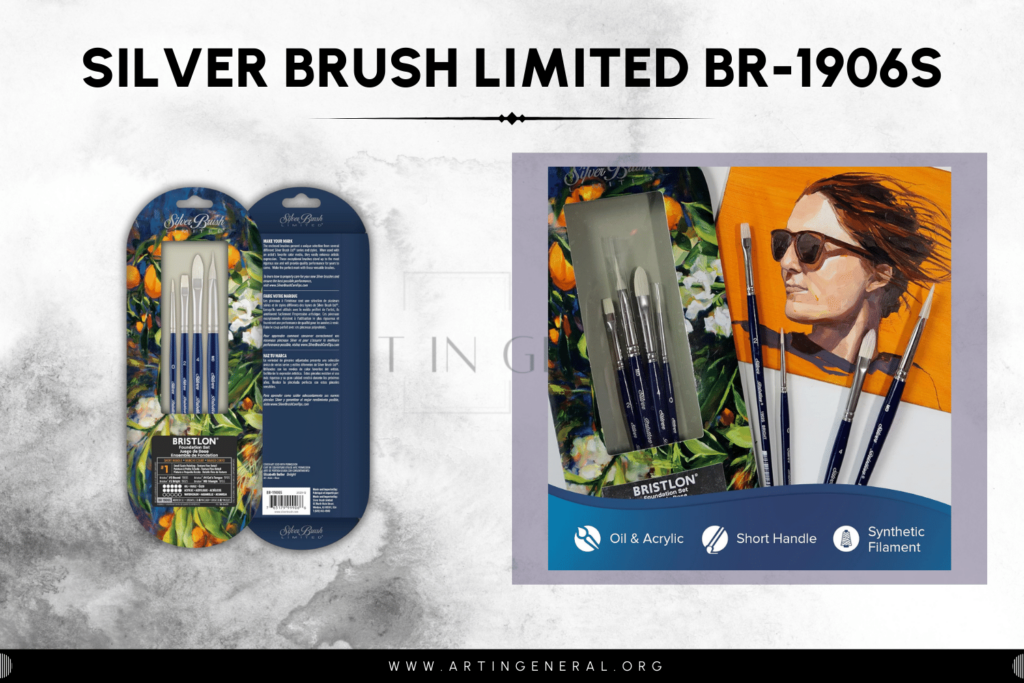
View Prices
About Silver Brush Limited BR-1906S Bristlon Fine Detail
Silver Brush is well known for making some of the best watercolor brushes out there, but they also make great brushes for acrylic, and if what you’re looking for is a dedicated set for fine detailing where you need all the precision and control you can get, then this is the set for you. These brushes are made with synthetic materials that mimic the natural stiffness and snap of hog bristles, but with much more durability and resistance. Their unique blend of filaments are capable of holding a very sharp point and edges, and can hold a lot of paint, which reduces the need for re-loading and allows you to work on those details for longer without distractions.
What makes them great:
- Presentation: 4 piece set.
- Our Score: 7/10
- Shape(s) and Size(s): Round(1); Cat’s Tongue(4); Triangle(4) and Bright(2).
- Our Score: 9/10
- Bristle Type: Synthetic bristle hair.
- Our Score: 8/10
- Handle Length: Short Handle.
- Our Score: 8/10
- Price: $39.97
- Our Score: 7/10
Pros
- Precision detailing
- Durable synthetic
- Retains shape
Cons
- Limited use
- Stiff bristles
View Prices
4. Best Acrylic Brushes for Mixed Media — Princeton Velvetouch, Mixed-Media Brushes
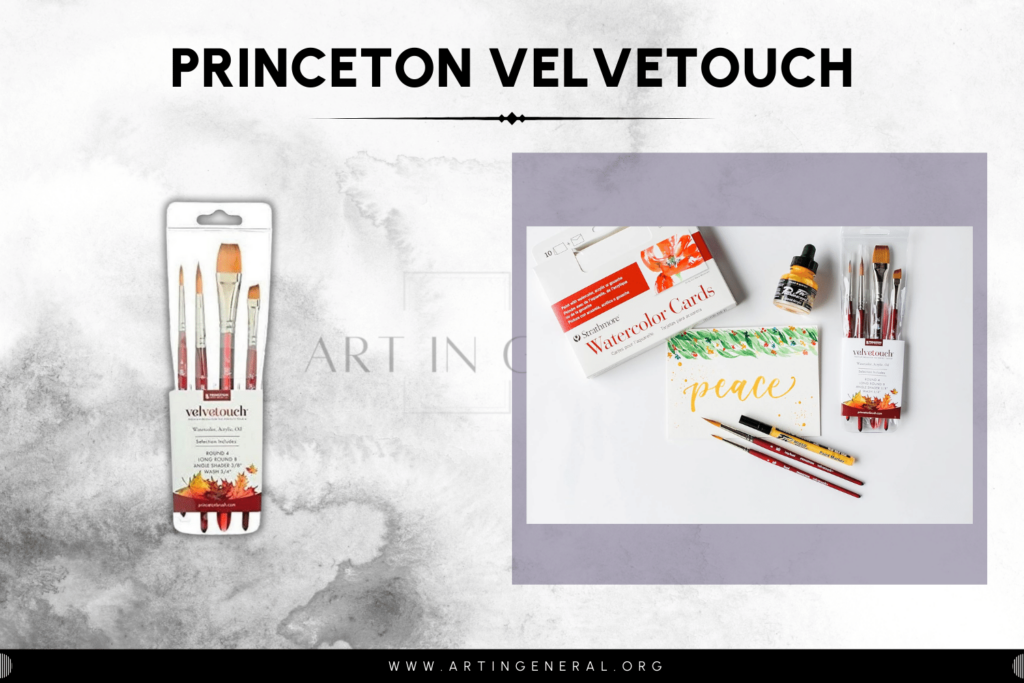
View Prices
About Princeton Velvetouch, Mixed-Media Brushes
If you’re looking for brushes you can use with any medium, then the Princeton Velvetouch Mixed Media brushes are for you. Made with exceptional attention to detail and engineered to mic the performance of natural hair, they show excellent paint retention, smooth applications and are able to keep a fine point after multiple uses. The handles are designed with artists’ comfort in mind, allowing for extended painting sessions without fatigue, plus the wide selection they offer in their complete collection caters to every artist’s need. The direct involvement of professional artists in the testing and feedback process ensured that the brushes met the high standards and varied requirements of mixed-media work and showed the compromise of Princeton with excellency and quality.
What makes them great:
- Presentation: 4 piece set.
- Our Score: 7/10
- Shape(s) and Size(s): Round(4); Long Round(8); Angle(3/8”) and Wash(3/4”).
- Our Score: 9/10
- Bristle Type: Synthetic bristle hair.
- Our Score: 8/10
- Handle Length: Medium Handle.
- Our Score: 8/10
- Price: $27.77
- Our Score: 7/10
Pros
- Soft yet resilient
- Versatile use
- Fine detailing
Cons
- Not for heavy body
- Moderate cost
View Prices
5. Best Acrylic Brushes for Beginners — Liquitex BASICS Acrylic Paint Brush
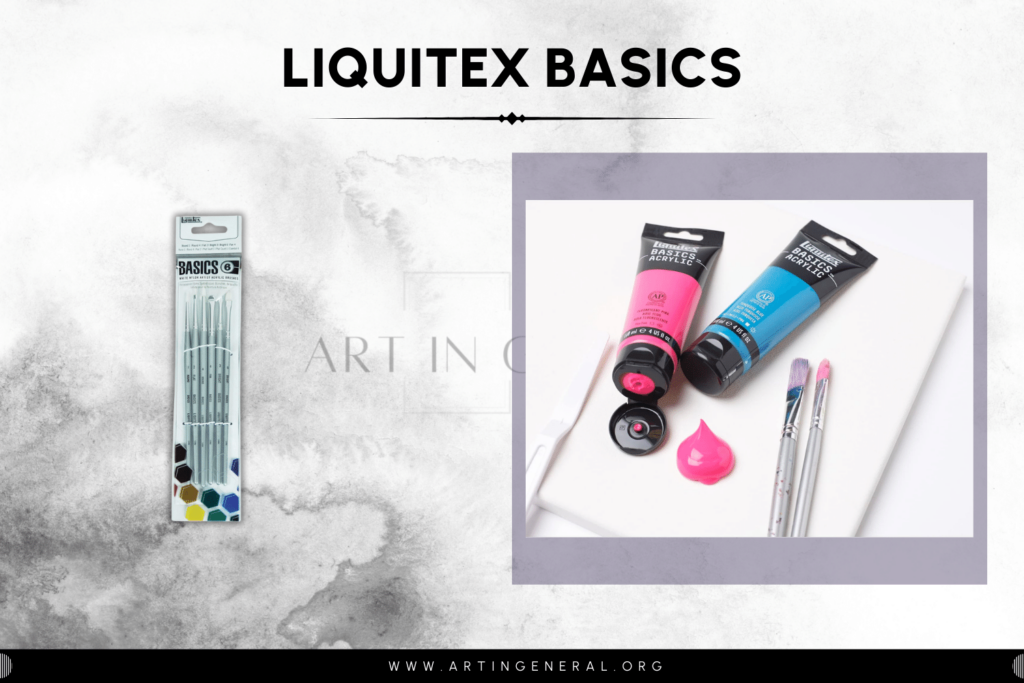
View Prices
About Liquitex BASICS Acrylic Paint Brush
For beginners looking for quality, affordability and brushes they can ruin without guilt, we have the Liquitex Basics Collection, which are specially designed to provide quality at an affordable price. These brushes can take a lot of wear and tear, proper of the early stages of learning, they can hold their shape very well and are very easy to clean too.
More importantly, the variety and durability of the BASICS brushes make them perfect for artists who are experimenting with acrylic mediums and exploring different techniques, and they’re very cheap.
What makes them great:
- Presentation: 6 piece set.
- Our Score: 8/10
- Shape(s) and Size(s): Round(1, 4); Flat (2); Fan(4) and Bright(3, 6).
- Our Score: 9/10
- Bristle Type: Synthetic bristle hair.
- Our Score: 8/10
- Handle Length: Long Handle.
- Our Score: 8/10
- Price: $7.97
- Our Score: 8/10
Pros
- Budget-friendly
- Good for beginners
- Easy maintenance
Cons
- Less precision
- Fewer sizes
View Prices
6. Best Acrylic Brushes for Professionals — Princeton Aspen 6500
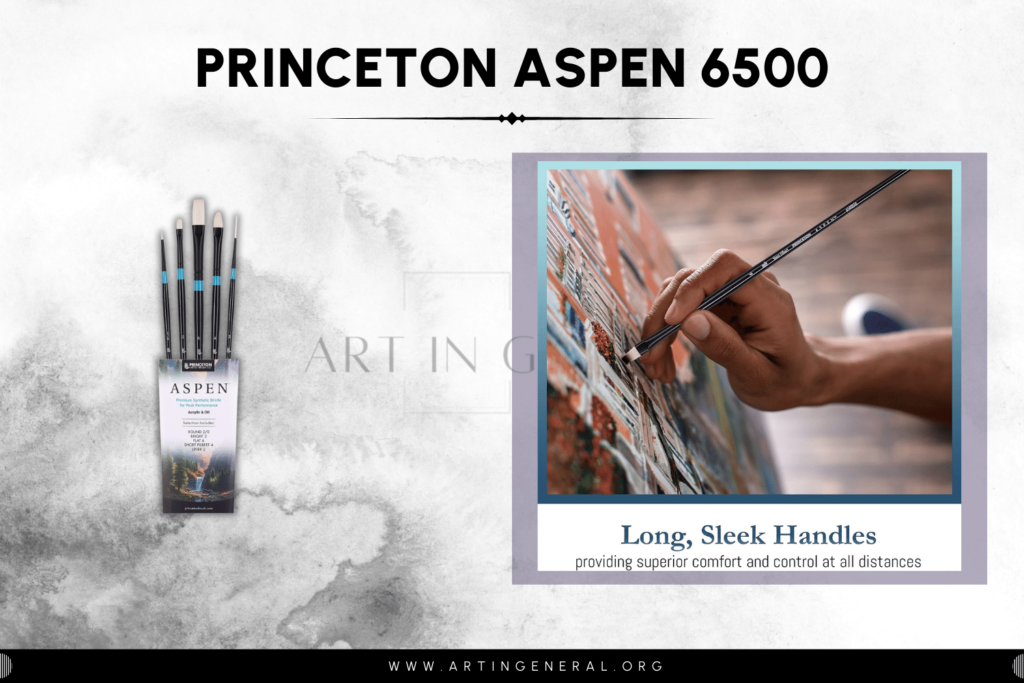
View Prices
About Princeton Aspen 6500
The newer Aspen line by princeton is a premium collection of brushes designed for professional use, made with a unique synthetic blend that mimics hog bristle brushes almost perfectly. These advanced fibers provide excellent stiffness, snap, and color-carrying capacity, which are essential for acrylic painting. Aspen brushes are designed to offer artists precise control over their strokes. The bristles’ fine tips and edges enable detailed work, while their stiffness is perfect for pushing heavier paints with ease. And since they’re made from synthetic materials, the cleaning process is a breeze and they last much longer even though they perform the same as natural hair.
What makes them great:
- Presentation: 5 piece set.
- Our Score: 7/10
- Shape(s) and Size(s): Round(2/0); Flat(6); Filbert(4); Rigger(2) and Bright(2).
- Our Score: 8/10
- Bristle Type: Synthetic bristle hair.
- Our Score: 8/10
- Handle Length: Medium Handle.
- Our Score: 8/10
- Price: $37.95
- Our Score: 8/10
Pros
- For all media
- Durable synthetic
- Professional quality
Cons
- Pricier option
- Heavier handle
View Prices
Taking Care of Your Acrylic Brushes
Before Using Your Acrylic Brushes

Paint brushes in general come with a gum arabic or gelatin coating, which makes them stiff and helps them keep their shape on their packaging and during shipping, this is meant to be removed with water by rinsing your brushes before using them. If you try to “break” the gelatin while dry you might also break some bristles and rin your brushes, same if you try to use them without rinsing them first.
During Your Painting Sessions

Here are a list of things you should avoid while painting:
- Don’t let the water get past the ferrule to the handle, this can make your brushes rust and lose bristles over time.
- Don’t mix paint with your brushes, use a palette knife instead and try to avoid getting paint on the ferrule.
- Don’t let your brushes soak in water, the glue holding the bristles together might wear off and your brushes will fall apart.
After Your Painting Sessions

- Wash your brushes with soap, if you manage to get soap made especially for acrylic, that’s even better.
- Always dry your brushes horizontally, on top of a towel.
- Store your brushes vertically once dry.
- If a brush is left to dry with paint, leave it soaking in rubbing alcohol or acetone and then use a conditioner soap afterwards to re-shape them.
Every Once in a While

Use conditioner soap to re-shape your brushes and leave them without rinsing, don’t use them for a day or two and they’ll have a significant change and last much more.
Change your brushes once they’ve lost their shape completely, although they can be good texture brushes or be used for other painting techniques, change the ones you use for certain purposes, for example, if a flat brush doesn’t fulfill its purpose anymore you can always use it as a mop or for blending but you’ll need another flat.
FAQ Section
Can I use acrylic brushes with oil paint?
While you can technically use acrylic brushes with oil paints, it’s not always recommended. Acrylic brushes are typically made from synthetic fibers, which can withstand the corrosive nature of acrylic paint but might not hold up as well against the oil and solvents used in oil painting. If you do use them with oils, thorough cleaning is crucial to maintain the brush’s integrity.
Can I use watercolor brushes for acrylic paints?
It’s best not to. Acrylic paint is thicker and can damage the softer bristles of watercolor brushes. Stick to brushes designed for acrylics for better results and brush longevity.
How do I clean acrylic paint off brushes?
Clean them with warm water and mild soap immediately after use. Don’t let the paint dry on the brush, as it’s hard to remove once set.
How often should I replace my acrylic paint brushes?
With proper care, brushes can last a long time. Replace them when bristles start to fray or when the brush loses its shape, affecting your work’s quality.
What sizes of brushes should I have?
Start with a variety of sizes to see what works best for your style. Small brushes (0-6) are good for details, and larger brushes (8 and up) are great for broader strokes and filling large areas.
Why do some brushes have long handles and others short?
Long handles are designed for painting at a distance, like on an easel, giving broader strokes. Short handles offer more control for detailed work, typically done closer to the surface.
Can I use oil paint brushes for acrylic painting?
Yes, but ensure they’re thoroughly cleaned if previously used with oil paints. Synthetic brushes are generally preferred for acrylics due to their resilience and stiffness.
How do I store my brushes after use?
Clean them well, reshape the bristles, and store them upright or lying flat in a dry location. Avoid storing them bristle down, as this can bend the bristles out of shape.


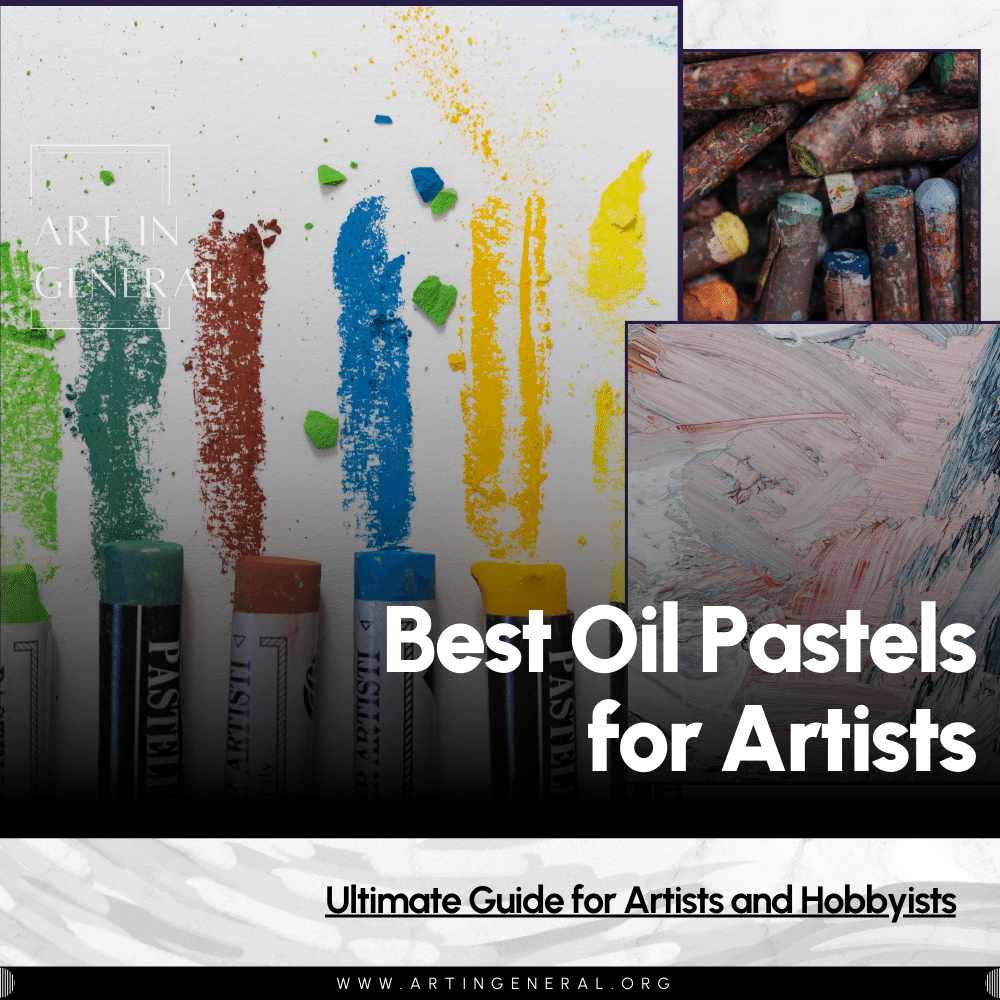
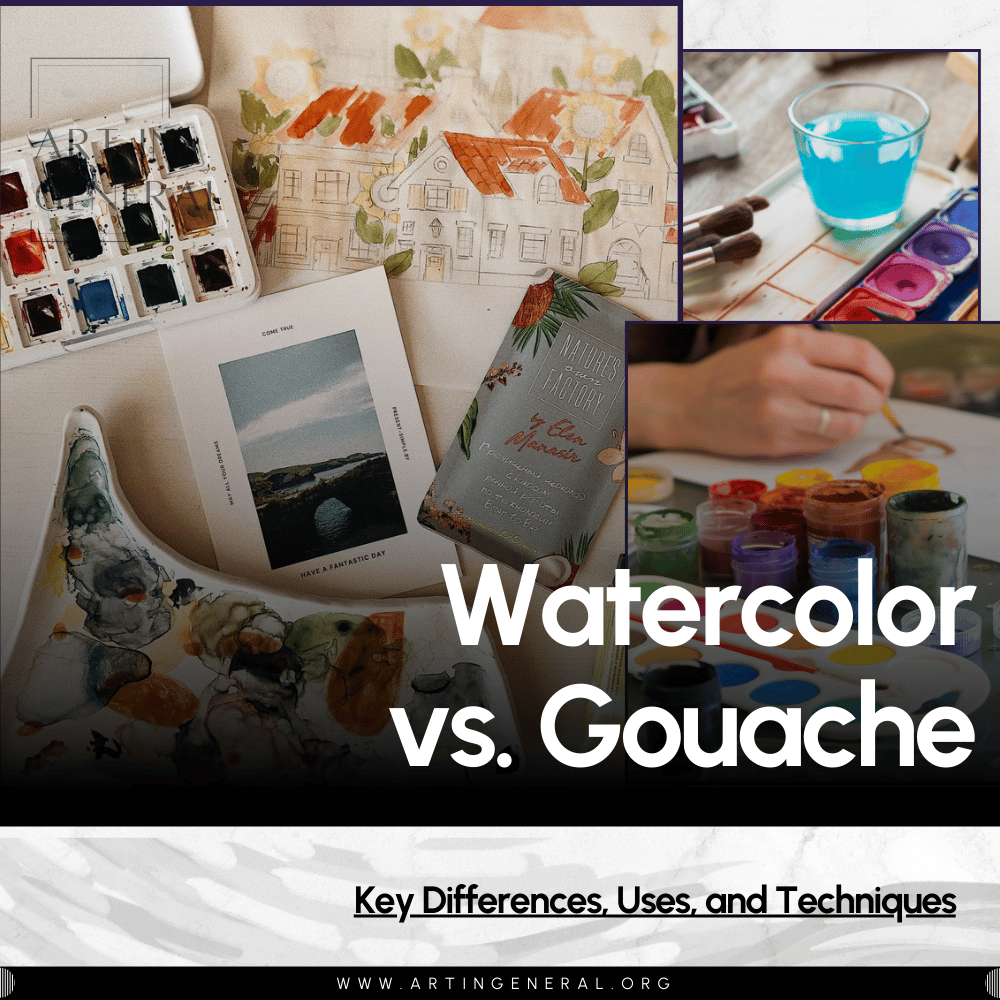

Leave a Reply